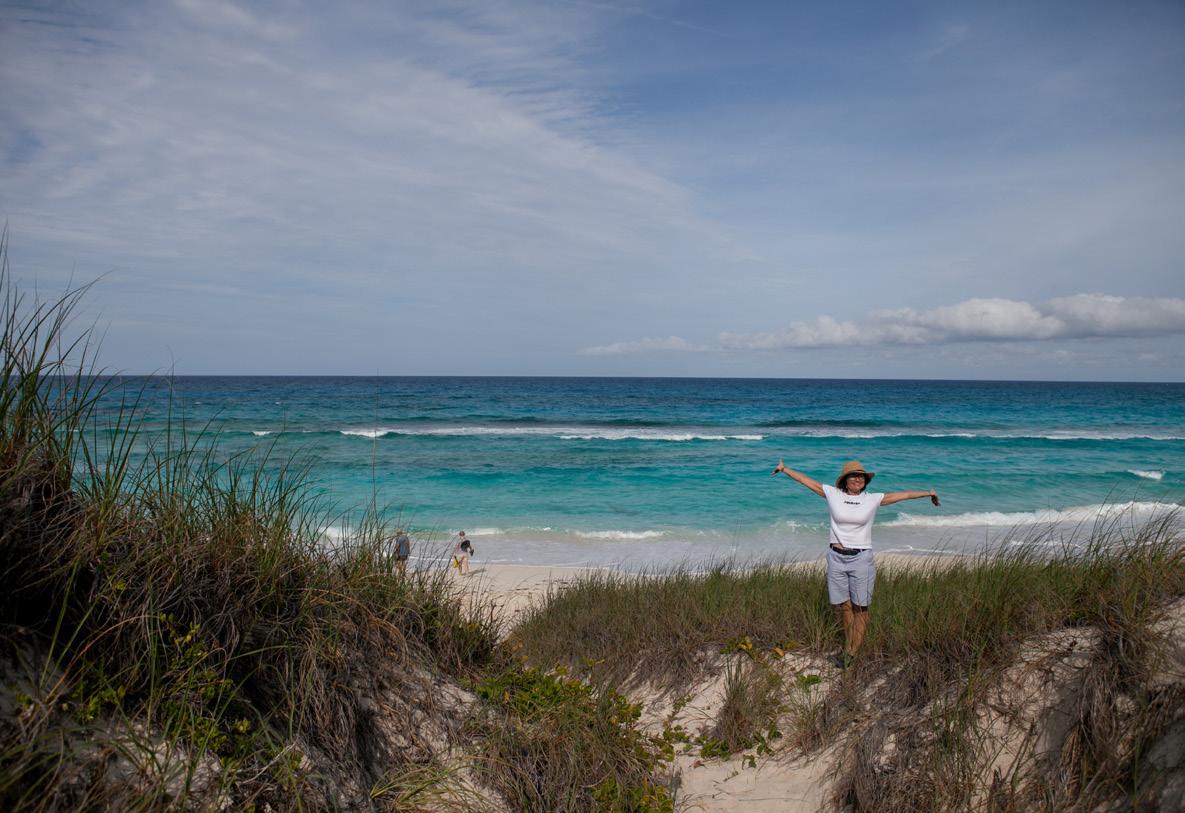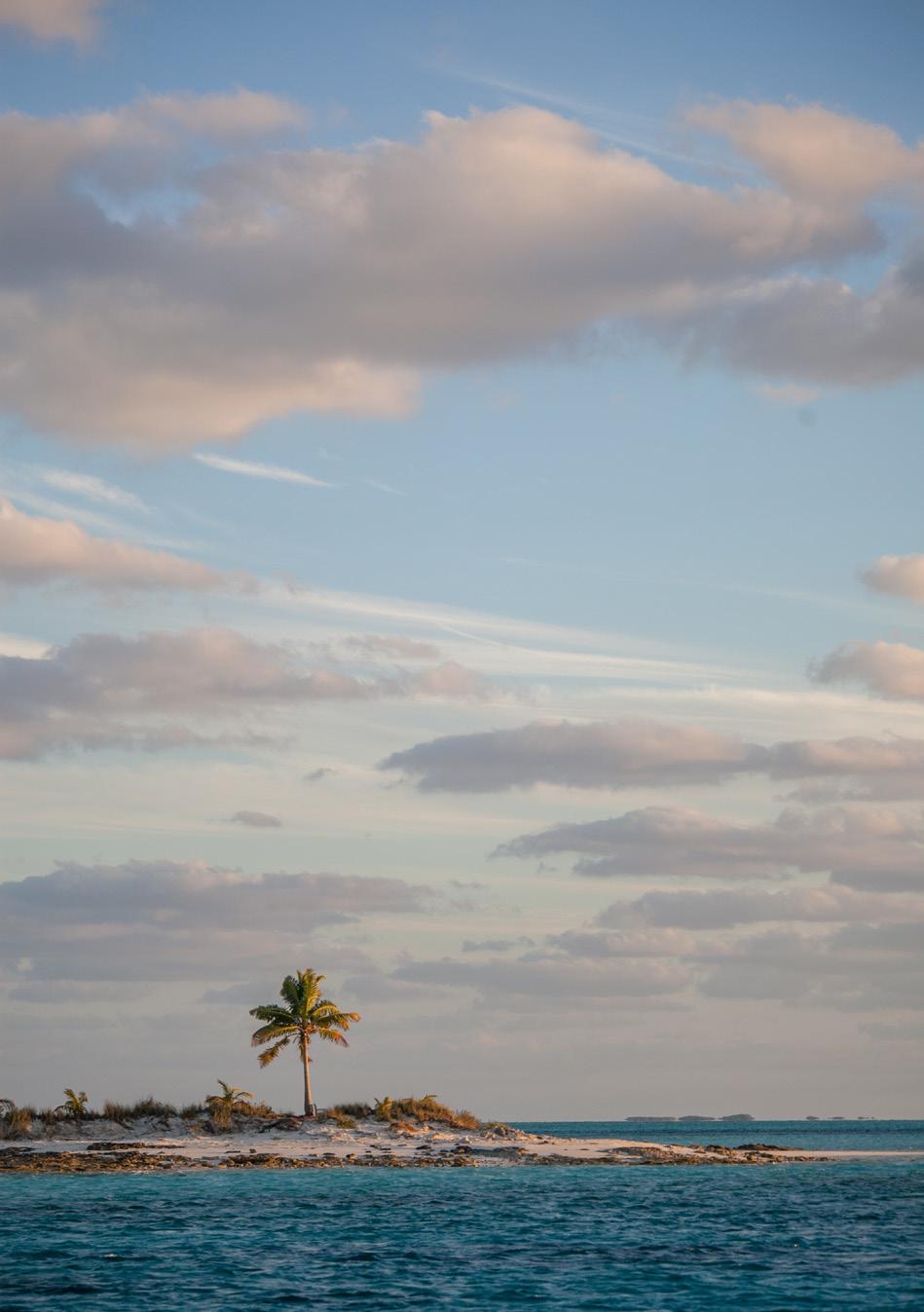
10 minute read
The Bahamas, water world
The Bahamas
WATER WORLD
Advertisement

Text BARTEK KAFTAN Photos JULIA ZABRODZKA
In the Bahamas islands and islets there is so much that everyone can find one just for themselves. But the real home for many of the inhabitants of the archipelago remains the ocean.
THE BAHAMAS
Little Abaco
Grand Bahama Great Abaco
NASSAU Eleuthera
Andros
Great Exuma Cat Island
San Salvador
Long Island
Acklin Islands
Great Inagua Mayaguana
Little Inagua
On the rope stretched above the deck are hanging a few silvery barracudas. Not many, it was not a big fishing, I do not think they went far. "But sometimes we spend two or three weeks at sea," says the captain, who is seated resplendently on a chair at the wheelhouse. For twenty days and nights, a cutter becomes the home of his crew: a dozen meters long, six, maybe seven. Is it hard to imagine? No, if you live in the Bahamas, a country of nearly 700 scraps of land – sometimes a little bigger than the boat of the fisherman we are just talking to in the capital Nassau. It is the homeland of the people of the ocean. “I regularly dive at 20–30 feet,” Errol from a smaller cutter nearby starts telling us his sea story. “Great exercise,” I answer. “Not bad for 62 years old, isn't it?” the slim and muscular man laughs. In fact, he looks a dozen years younger. But he does not dive either for training or for pleasure. This is a popular fishing method in the Bahamas. Fishermen go out to sea not only for fish, but also for crawfish, and like Errol, for wingers. Living in huge, beautiful shells, snails are one of the local delicacies. “To



catch them we swim east, towards Eleuthera, or south, to the Exuma Cays,” he says. “You can find conchs everywhere where the ocean is shallow and the bottom is sandy,” he adds. And the Bahamas are a maze of shallows, backwaters and narrow spaces. Today, this white and turquoise landscape made of sand and water attracts thousands of tourists, formerly it was the terror of captains. It is estimated that over three thousand Spanish, British and French ships have sunk since the 16th century in the area difficult to navigate. However, it is a paradise for snails. “But that's not what it used to be,” Errol sighs. “You catch too many of them, you poach too much. There are less and less of them.” ***
A spirit of nostalgia and bygone glory hovers over the entire harbour on Potter's Cay, the connected island in Nassau. On the wharf there are piles of crates, rusty barrels, cats fighting with gulls over the remains of the gutted fish. From several pubs on stilts you can hear loud voices of cooks, sizzling oil, rhythmic sound of knives chopping snails and the hiss of opened bottles. On the water you can see small boats and freighters that were patched and painted so many times that no one remembers their original colour. And smaller boats that will not go anywhere anymore. They have dropped anchors here for the last time and are used as raft houses for survivours. This place does not compare with a posh habour of cruise ships that dock right in the center. Their massive bodies look down on the one – or two-floor buildings of Nassau.
Nevertheless, the sea heart of the capital and the entire archipelago is beating on Potter's Cay. It is from here that the postal freighters, a real Bahamian institution, set off to the furthest corners of the country. “Mail boats have been in the archipelago for two hundred years, once under sail, today with an engine,” says Lance Brozozog, the captain of the Grand Master, who will be taking the night cruise to George Town situated on Grand Exuma. This is one of several regularly operated routes. “Captains sign contracts with the government for the transport of parcels and letters, as well as goods and passengers. The idea is for each inhabited island to have a permanent connection to Nassau,” explains Lance, leading the Grand Master out to sea. Today on board he has planks and building materials, a lawn mower and TV sets, medicines and a laundry basket, tableware and packets of drinks, patches of grass and garden chairs, and a motorboat on a tow truck. And, of course, letters and a few passengers. People who can choose prefer a flight lasting several dozen minutes instead of a cruise lasting several hours. In the past, however, only freighters reached many islands. “I took over the mail boat from my dad Lenny,” says Lance. “And the first one in the family

who sailed (at that time without an engine) was Uncle Rolly. He was a great captain and sailor. We named the ship the Grand Master in his honour,” he says. But he also knows his trade and the secrets of the waters washing the Exuma Cays so well that when the film The Pirates of the Caribbean was shot here, it was he and not the captain Jack Sparrow with a non-north compass who guided the famous Black Pearl from its hiding. ***
"Welcome to the home of Grand Master" – we read on a tin plaque at the marina. Behind it, the town begins: colourful houses with Caribbean-style porches, tropical greenery, mango trees with fruit, purple bougainvillea garlands, red hibiscus stars. Peace and quiet, the hens peck crumbs from the cracks in the asphalt, the policewoman is dozing in a melex. You do not need a car here. Staniel Cay, Rolly Gray's hometown islet, is a kilometer wide and three long. Just over a hundred people live here permanently.
We check in at the marina a few days after our departure from Nassau. A mail freighter drove us to George Town on Great Exuma Island. From there, we continue our Bahamian sailing cruise. We sail northwest along the Exuma Cays, a chain of over 350 tiny islands. On the first day we stick to the eastern side, swayed by the mighty Atlantic waves in the deep blue waters of Exuma Sound. The next day we squeeze through one of the inlets, and the sea landscape changes beyond recognition in a few minutes. We sail on the flat, turquoise surface of the Great Baha-


ma Bank, alternately exposing our faces to the sun and looking for starfish on the sandy bottom, a few meters below the keel. The sheltered waters of the Exuma Cays are the mainstay of traditional Bahamian sailing. The characteristic wooden poles with a huge spearhead, and beams protruding far beyond the sides, from which the ballasting crew is hanging, can be seen in both George Town and Staniel Cay. Unfortunately we do not manage to see the traditional annual regatta, which is one of the most important holidays on individual islands. This was where Rolly Gray raced, and he was without equals. He won several times one of the most prestigious competitions – April Family Island Regatta in George Town. The last time was in 1998, he was then 76 years old. The Exuma Cays are still one of the favourite spots for yachtsmen, but today luxury yachts are seen here more often than traditional wooden boats. Really luxurious ones. When we come to the marina from the anchorage, we moor our modest pontoon near a two-floor, shiny giant under the flag of one of the Caribbean tax havens. A girl with the appearance of a model, wearing a bikini and airy dress, is coming ashore on the gangplank. Watched by all the customers of the port tavern, she slowly approached the place where the sharks lured by the rePeace and quiet, the hens peck crumbs from the cracks in the asphalt, the policewoman is dozing in a melex. You do not need a car here. Staniel Cay, Rolly Gray's hometown islet, is a kilometer wide and three long. Just over a hundred people live here permanently.
mains of the fish were roaming, she pouted her lips and snaped a selfie of the predators swirling like in a snake nest. A scene like from the Bond movies. And this is no coincidence, though. After all, it was the nearby underwater cave that played one of the enemy's hideouts for Agent 007 in the film Thundeball. ***
In this film, the villains from the organisation Specter hide a British military plane with atomic bombs in the shallow waters of the Bahamas. Two days later, on Norman's Cay, we come across some traces of an equally improbable but not at all cinematic story. On the shores of the islet, we are greeted by





a ruined tropical bungalow with a sunken palm thatched roof. In the thicket of greenery, we notice concrete steps, we climb them through the wild garden to the terrace. The remains of the roof cast an openwork shadow on the stone floor. The view is a bit overgrown with palm trees, but it is still stunning: a turquoise bay, green islands in the background with white lines of beaches, and a few anchoring yachts in front of them. Some time ago there were probably no boats here, only a select few had access to the island. Perhaps the host welcomed them on this terrace, offering them the most expensive rums in the world in the bar that is now empty. He could do anything. Carlos Lehder Rivas, who bought almost the entire island in the 1970s, was one of the founders of the Medellín cartel. From 1978 to 1982 Norman's Cay was its headquarters and terminal for cocaine from Colombia to the United States. Lehder had
his own army of security guards, a pack of Dobermans, and an airfield with radar. At the time of the cocaine boom, up to 300 kg of drugs a day passed through the island. Not everything went according to the plan. After returning to the yacht, we put on our masks and fins and jump into the



water. In the middle of the bay, at a depth of several meters, we see a plane wreck. The bow is facing south, the pilot's cabin is shattered, the right wing is embedded in the bottom, but the propeller still is hanging above the sand. Apparently, no one was eager to haul the DC-3 plane out of the water that missed the runway – Lehder's men limited themselves to retrieving the valuable cargo. We dive under the left wing, we look inside the fuselage through the windows, we scare the school of green and blue wrasses spinning around the exposed engine mechanism. Ever since the Bahamas authorities confiscated the property in 1983, tropical nature has slowly absorbed the traces of the drug empire – whether on land or in water.
Before the evening we sail to a nearby island. It is nameless, to our knowledge, like many in the Bahamas. But who would care to name a piece of land that is little bigger than a cutter or yacht? Hundreds of young conchs lie in the shallow water washing the sandbanks, in the middle the flat line of the horizon is broken by a trunk of a palm tree. There is a small plaque right next to it. "In memory of Mrs. and Mr. Turner," we read. Apparently they were sailors and they loved this place. It is not surprising. We sit under a lonely palm tree and look at the Atlantic. It is good to think that you do not have to be a millionaire, a smuggler, or an agent of Her Majesty to have your own island somewhere in the world. Even a quite tiny one.

ADVERTISEMENT
DIVE STRONG. DIVE ZEAGLE.
Every mission. In every condition. Zeagle has your back.









